How to Make Compost and Use it
How to make compost, what are the benefits of compost, and what can you put in your compost bin.
Do You Compost?
BAM!
…and just like that, I’m all up in your personal business! But we’re all friends here, so I hope I haven’t gone too far and that it’s O.K. to delve into this personal matter.
Terry and I realized very early on in our Organic Vegetable Garden journey that the quality of our soil was the Number one determinant of the quality and quantity of our garden harvest. To that end, we amend our very sandy soil with compost every year. Compost is literally alive with microorganisms, worms, and bugs, which are very beneficial to add to the soil of our organic vegetable garden.
The decomposed vegetable matter that results after the composting process is fondly named ‘black gold’ for a reason. Good compost will improve your soil structure, add nutrients to your soil, and reduce the amount of water you need. Additionally, good compost will fight plant diseases and insects that a more sterile soil cannot.
Benefits of Composting: Recycle your Kitchen and Yard Waste
- Composting is nature’s way of recycling. Food, leaves, and grass breakdown produce the rich organic matter of humus. Humus is vital for healthy gardens as it is rich in microbial activity, insects, and micronutrients. Your gardens will be richer and healthier because of the compost you add to them.
- What you compost at home doesn’t need to go to our landfills, thereby reducing all the dangerous by-products of burning the waste.
- Instead of buying a bag of compost at your local hardware store, save the money and fuels necessary to package and transport it by making your own at home.
- The list of items you can compost is long. Obviously, any vegetable or fruit can be thrown into your compost bin. But coffee grounds, tea bags, and newspapers printed with soy ink are also compostable.
What Can You Compost?
Let’s grab ourselves a compost bin and get busy! In the perfect world, you will have a ratio of 2:1, Green matter to Brown matter. The GREEN MATTER would be those typically soft, fresh or wet items, e.g., discards from salad prep or the old veggies from the bottom of your produce drawer, while BROWN MATTER is usually hard, dry or dead material, think dried leaves and such here.
Truthfully, I’m not going to measure and weigh my compost additions to ensure that I have that ratio. In the worst case, if you have too much green, your bin will start to smell, so add some brown. If you have too much brown, it will just take longer for your compost to be finished.
- Raw or cooked Fruit and Vegetable peelings, cuttings, leftovers, etc… (Avoid those with butter or oil)
- Coffee grounds and filters
- Teabags
- Shredded Newspaper
- Fishbones, scraps, shells (bury them 10-12 inches deep to minimize smell)
- Wood Shavings from untreated wood.
- Old/Outdated seeds
- Seaweed
- Corncobs
- Dry Leaves
- Hair/Fur
- Bad Wine or Beer
- Nutshells, other than Walnuts (broken down if possible to speed up decay)
N&N Fun Fact for the Day: Walnuts contain a chemical called Juglone which is toxic to Tomatoes…who knew!?
- Eggshells (broken down if possible to speed up decay)
- Fruit and Vegetable pits and seeds (including olive, date, etc…)
- Plant trimmings
- Grass clippings (avoid if has dog waste on it)
- Wood ash from your fireplace
- Plant trimmings (avoid fibrous or very woody plants or shred them before adding)
- Pine Needles
- Shredded brown paper bags and cardboard, but avoid heavily printed material.
- Lint
- Contents of Vacuum Cleaner Bag if your home isn’t heavily carpeted (want to avoid polyester/nylon)
- Sourdough Starter Discard
- Kefir grains
What to Avoid in Your Compost Bin
- Bread Products with sugar.
- Any oils (cooking or motor)
- Diseased Plants
- Aluminum Foil, Magazine/Catalog Paper, Thermal Receipt Paper
- Animal and Human Waste, unless from non-carnivorous animals like cows, chickens, rabbits
- Meat Products
- Rice
- Milk Products
- Sawdust from treated wood
- Weeds as they will happily propagate
- Anything with human blood
- Weeds with seeds
How to Compost: What Equipment You Need to Compost
Some of these links may be affiliate links and I may earn a small commission off of the sale of these products to help defray the costs of operating this site, but the price you are charged is not affected. You can see my full disclosure policy here.
There is no equipment that is absolutely necessary for making compost. You could build your own bin with a couple of lengths of lumber or pallets and some nails very easily. Ideally, you would make two of these bins, turning the ‘hot’ compost from one bin to the empty bin as necessary. The downside to a compost bin like this is that it is not animal proof and you will most likely attract rats and raccoons to your composting bin.
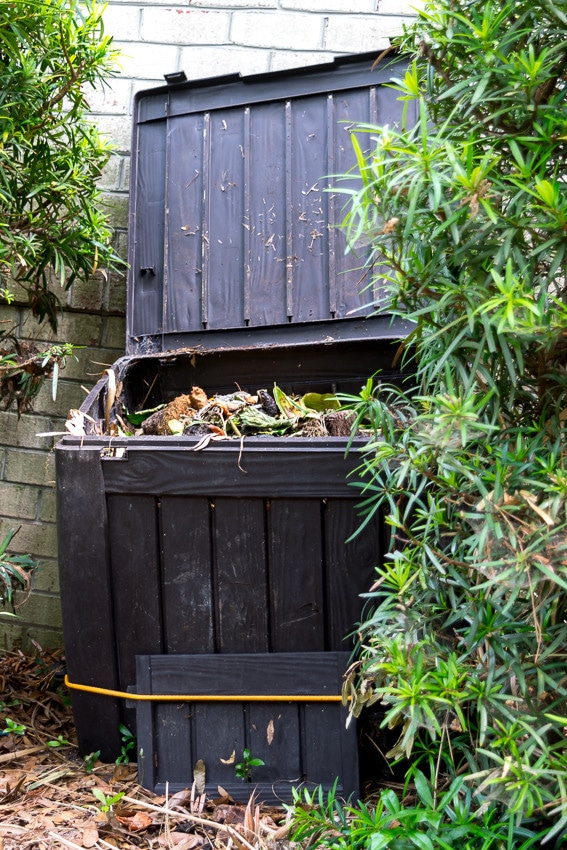
Table of Contents
If you aren’t into building something now, many options are on the market. There are Stationary Compost Bins, one of the types we use.
These stationary bins usually have the largest capacity, weighing 10-15 cubic feet. They typically have a ‘door’ at the bottom where the finished compost will settle and be easily retrieved. The downside of these compost bins is that they are hard to aerate the contents, which means it will take a bit longer for your raw materials to transform into finished compost.
I do like that this bin sits on the ground, making it accessible to beneficial worms, insects, and microorganisms. You can find them at most hardware stores and on Amazon. Often, city and county waste services will offer them at discount prices.
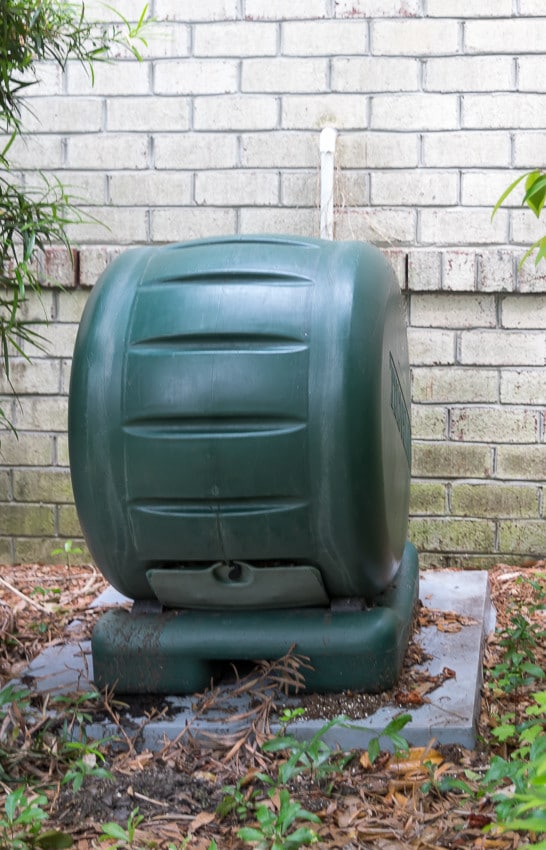
Another option we use (yes we have two…we are very SERIOUS about making compost) is the Compost Tumbler which is a sealed container that can be turned to speed the decomposition process.
These tumblers typically sit off of the ground and, as such, don’t provide access to the beneficial worms, insects, and other micro-organisms. However, it is very appealing to be able to turn your compost to aerate it regularly, thus speeding the process. These tumblers can be found at most hardware stores and on Amazon.
If you don’t mind making compost indoors or possibly in your garage, Worm Composters are another option. These composters are composed of trays on which your waste is placed The worms travel up, consuming the new waste and leaving the nutrient-rich waste and compost on the bottom tray. Worm castings are considered super-duper black gold in a garden.
I have two of these compost buckets that I rotate and keep under my kitchen sink. My son empties the bucket into our compost bin each night after dinner. We avoid the fruit flies accompanying a compost bucket by emptying it frequently.
However, I keep a little fruit fly trap under my kitchen sink as well, just in case these little pesky critters crop up. My fruit fly trap is nothing more than a bit of wine/beer/vinegar with just a drop of dish soap in a glass jar with small holes in the lid. I will also add a small piece of fruit to the jar. The flies go in through the holes, and the small bit of soap ultimately makes them unable to fly.
How to Speed Up the Composting Process
From the first day you put your first scraps in your bin until you can ‘harvest’ some of the black gold can take up to a year or 18 months. That process can be shortened by employing the following:
- Make sure your compost pile is the right size; too large or too small, and you won’t get the microbial action you need. The optimal size is 3 feet wide by 3 feet tall.
- Keep the green:brown ratio as close to 2:1 as possible. If your pile needs a boost, you can always add nitrogen in the form of blood or bone meal.
- Shred or chop the material you put in your compost bin. Smaller items will understandably compost quicker.
- Aerate it.
- Occasionally add some compost tea to infuse it with micro-organisms, and keep it moist, like a damp sponge but not soggy.
How to Use Your Compost
We use our black gold in a variety of ways:
- We mix compost into our soil when we plant our new plants in the spring and fall. The added nutrients and moisture in the soil help your plants get off on the right foot.
- We add some as mulch around our vegetables (or any plant) during the growing season. It helps keeps weeds down, the soil moist and continues to feed the soil.
- We continue to amend our soil with compost whenever we have enough
- We make compost tea in our compost tea brewer to feed our plants and soil throughout their growing season. Here’s more on our compost tea and some helpful tips on how we apply it to the garden

So, it’s no surprise that you will find Terry and me in our garden this weekend, digging into our compost bin to top-dress our vegetable plants with the rich soil and starting a batch of compost tea. Have you planted your vegetable garden yet? Any tips or secrets you’d like to pass on?
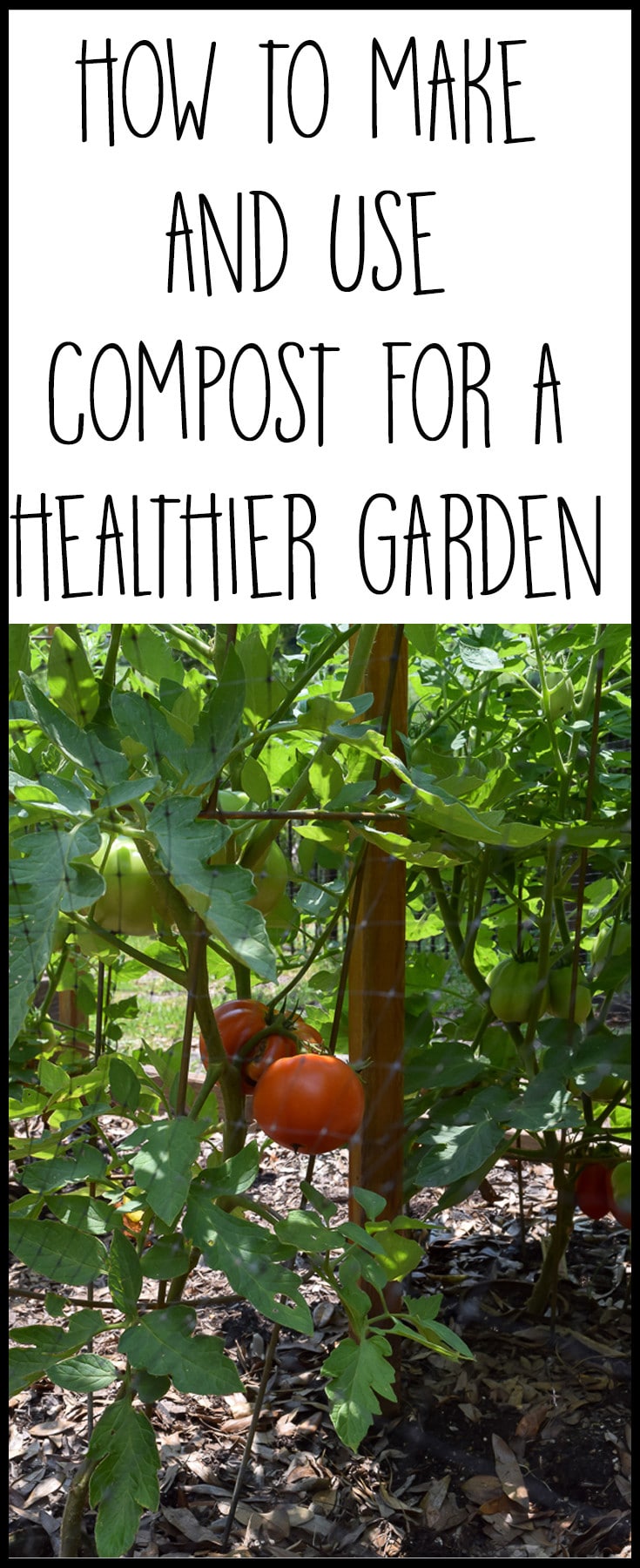
If you are interested in the benefits of composting to improve your soil for healthier and more productive plants, pin this for your future reference:
Thanks again for spending a few minutes of your busy day with me today.
Please know that I welcome each and every comment that comes my way.
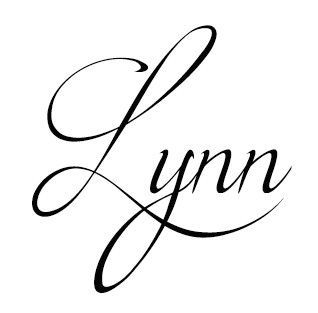

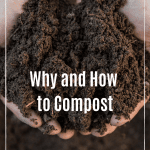

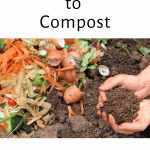
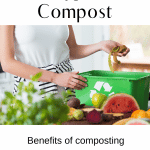
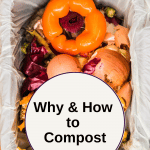
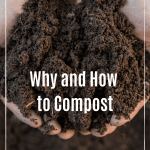
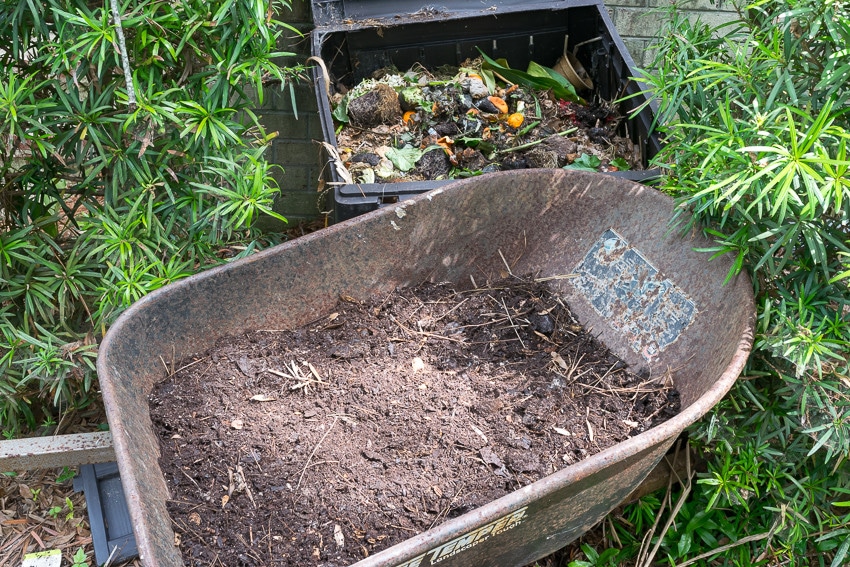
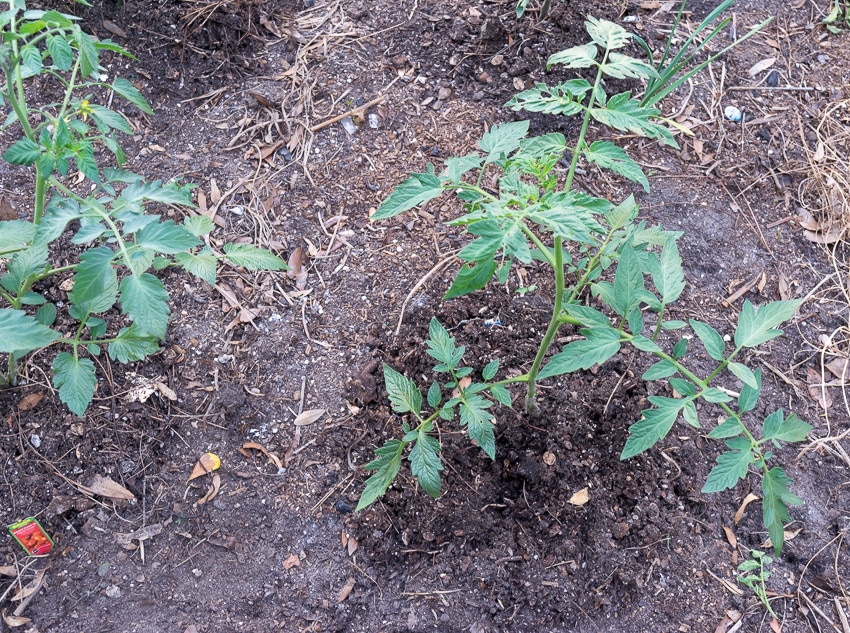
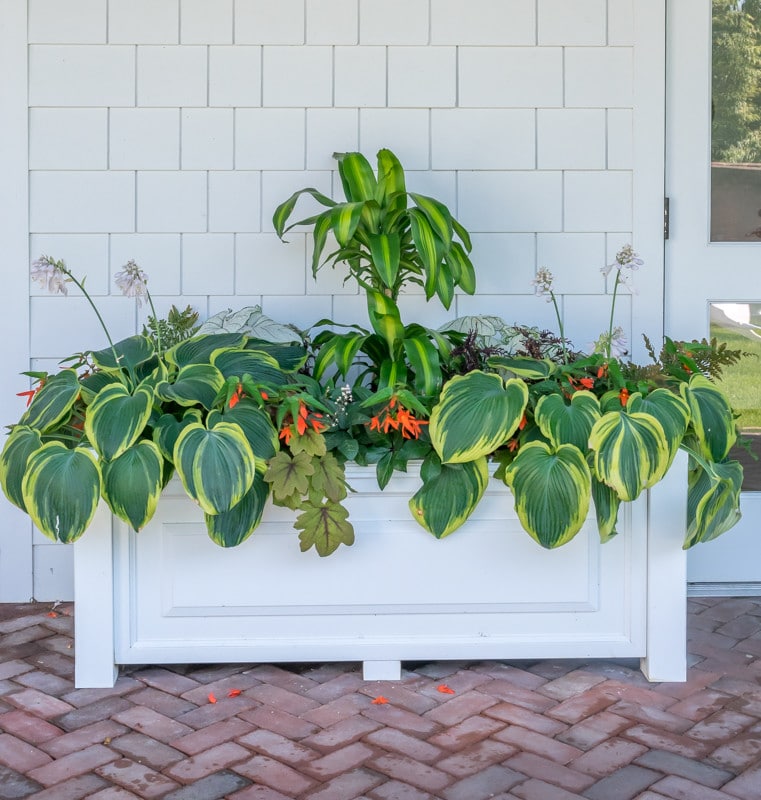
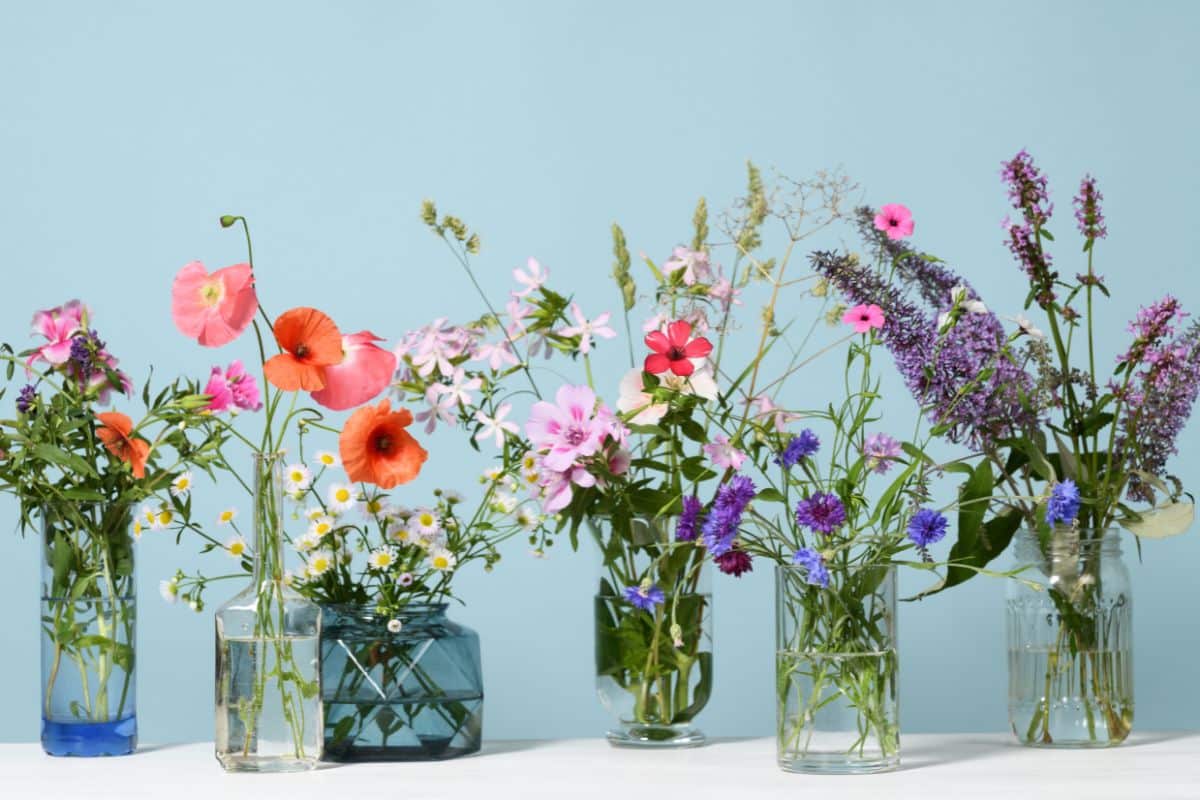
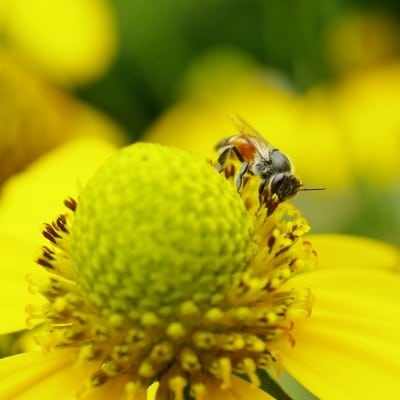


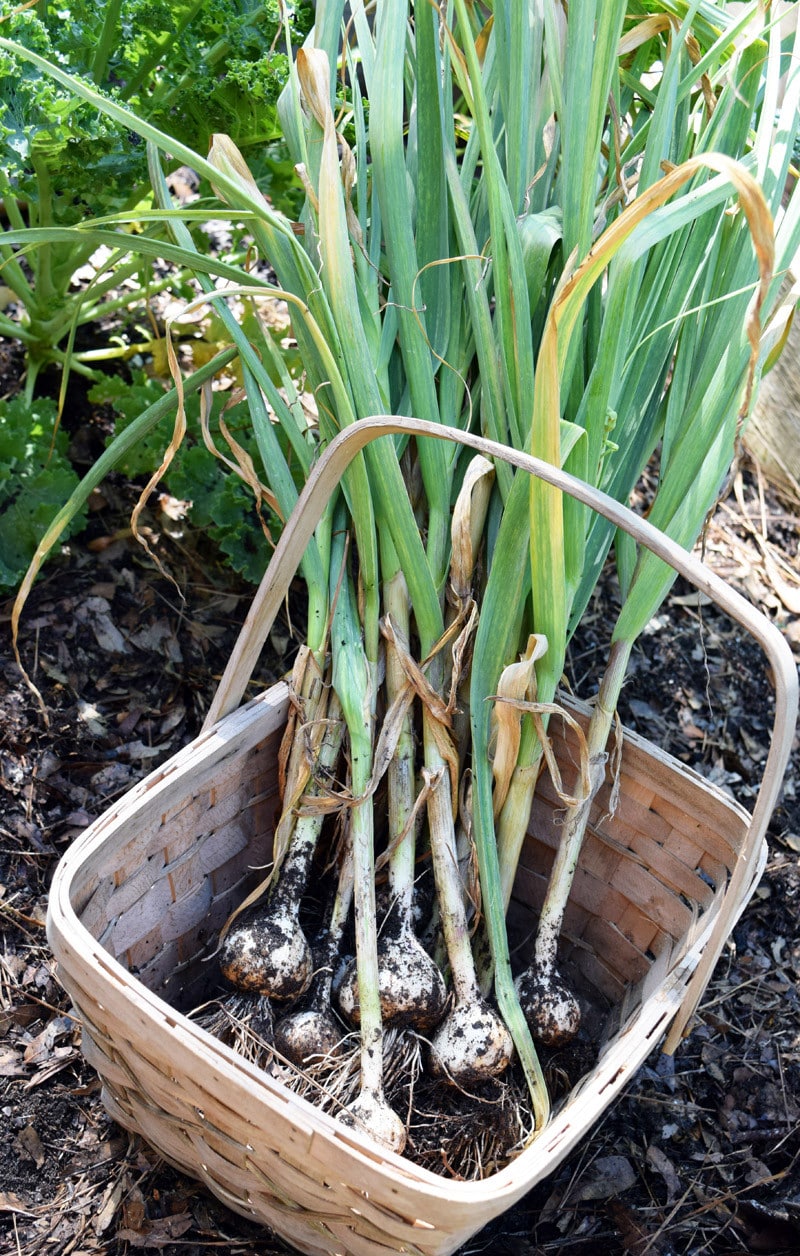
Wow, Lynn, what a comprehensive composting post! Such great tips there. We’ve always composted, and what doesn’t go in our composted our city picks up. Everyone composts here – like it or not. :). My one and only pallet project was to make a composer from 4 of them.
I DO know about walnut juglone toxicity – we have a beautiful old Black Walnut tree in our yard that kills pretty much every plan that’s nearby. There’s only a precious few plants that can grow there – which I learned after it killed $$$ plants on me for years!
What a great article. I have 3 bins running. My 1st two took a while to get going. Rookie mistakes. Moving to a sunny spot and doing 2:1 helped. Thanks..
You have THREE! I am clearly the novice here. Having that heat is so important to get the piles cooking.
But don’t you just love all the goodness that results at the end of the process? We just put out a load of compost around our veggies this weekend and I’m pretty sure they are still smiling.
Happy Composting my friend!
So, all we need is a trivial pursuit question that asks ‘which nuts are toxic to plants?’ right?
How great that your city ‘mandates’ composting…ours does not. We are not even required to recycle, which I find mind blowing.
Thanks for coming by.
Hugs, Lynn
Wow, so comprehensive! Since I live in a Townhouse community, we don’t do it but what a great idea!
Yup, I’d imagine it’d be hard in a town house community.But you know where to find the info if you ever do need it!
Thanks for sharing the raw materials list. That’s what I need. Did you deal with maggot in compost Lynn?
Hi Kate, Truthfully I have never seen maggots in my finished compost but I wouldn’t be surprised if there are some in there from time to time. The maggots will most likely be there when the green/brown balance is too heavy on the green side, so if you do see maggots just add some brown matter.
BUT, all that being said, the maggots will actually speed up the composting process and will most likely be in the part of the bin with the ‘fresh’ material and not in the finished product.
Hope this helps!
Hugs, Lynn
Oh! I’m glad to hear from you. I’m learning to make composts and dealing with some problems. Thanks for your share.
One more addition that is an amazing boon to you compost is horse manure. If you live anywhere near an equine facility take some buckets or pails over. There’s always plenty, and it would be very unusual for the facility to hold back on letting some go. It’s a tremendous source of nitrogen.
You are so right Rosanne!Thanks for tossing that suggestion out. I really could have used some manure this spring as my garden was really low in Nitrogen.
As a kid growing up in England we had an allotment where my Dad grew most of our fresh food. In those days most recycling was done by ‘rag & bone’ men. They traveled the streets with a horse & cart calling out ‘Rag & Bones’ & people would give them anything they no longer wanted. We were under strict orders from our Dad that anytime we saw the horse poop we had to run & tell him. He would rush off with his shovel & wheelbarrow to scoop it up & add it to the compost pile at the allotment. He knew all about the ratios & letting it rest etc. Fond memories!
Oh, Carol, what I wouldn’t do for some good horse or cow manure! And I’m so glad I was able to bring back some fond memories. Good memories are such a gift.
Thanks for sharing your memory!
Hugs, Lynn
Hi Lynn, great article!! I have composted in the past, but worry about attracting vermon. I know you said to avoid bread but won’t the other food scraps, mainly vegetable clippings attract them as well? I’m really hoping to start up again, but am worried about this. Thank you for any advice.
Hi Shari,
Well, truth time…we did have a rat at one time but our cat took care of him/her. BUT…we no longer have a cat that goes outside, so we made sure that there weren’t any gaps between any of the sides of our stationary square bin. However, I don’t think that rats/mice could get in our tumbling bin as it is off of the ground and fully sealed. So…I think for ‘vermin avoidance’ that might be your best option.
Thanks for writing in Shari and hope you have a fantastic week.
Hugs, Lynn
I have learned that you do not use anything that smells fishy, coons will tear everything up trying to find it. They even dug up a baby barrel cactus and sat on my begonia while digging.
Hi Dorlis, Luckily raccoons are not a problem in my area, but I imagine that is good advice. But I’m curious, was there something fishy smelling under your cactus?
Over 50 yrs ago, my mother kept a bucket by the stove. She would put her veggie peelings, coffee grounds, tea leaves, left over coffee & tea, egg shells, etc in the bucket. When it got full, she’d take it outside & pour it on her veggie garden to ‘feed’ the earthworms. One evening my aunt & uncle & their kids were visiting for dinner. We teenage girls had the job of cleaning the kitchen. My cousin started to scrape the leftovers from the plates into the bucket. My mother stopped her, saying “oh, no, that’s my worm bucket to feed the earthworms.” Since my mother fed all stray animals & the wild birds, my cousin laughed & said “Aunt Evelyn, I knew you fed everything else, but I didn’t know you fed the worms!” To this day I still keep a worm bucket. I like to think my mother was a trend-setter with her early composting. She always had a bumper crop of veggies. I guess the worms were happy.
Oh Gayle, what a lovely story and memory! Your mom was clearly ahead of her time…although I do believe that in many ways our elders were so much smarter than we are…the ‘old ways’ are often the best ways.
And there is nothing that makes me happier than digging in my soil and finding a bumper crop of wriggling worms. Taking my kitchen scraps out to the compost bin and then spreading the resulting compost on my garden and watch it feed my garden is so rewarding…a full circle kind of thing.
Thanks for popping in today!
Many hugs, Lynn
OWe have an excellent municipal composting program in our area, and we can reap the benefits and pick up compost at the recycling facility!!
No Way!!!! LUCKY! That’s a great service offered by your municipality.